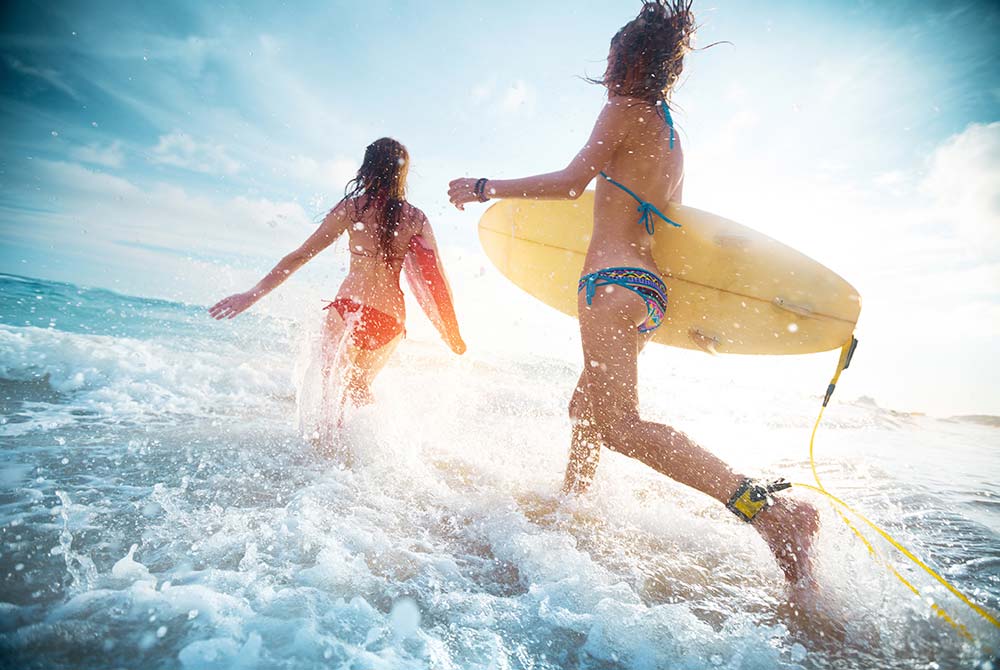Playtime in Australia
One of the reasons people are so happy living in Australia (Australia has consistently ranked in the top 10 World’s Happiest Countries for 5 years now!) is because there is so much fun to be had both outdoors and indoors.

Sports
Sport is an important part of Australia’s cultural identity. Some of the most important events in the country’s national memory have been sporting achievements. Participation in sport is a large part of many Australians’ lives, and joining a sports club or team is a great way for students to meet people and form strong social connections.
Cricket
With many of the states’ capitals hosting a Test match some time from October to January, as well as limited overs fixtures, international cricket matches will be accessible for many. The biggest match is undoubtedly the Boxing Day Test held at the Melbourne Cricket Ground from December 26th, but in recent years huge crowds at the Adelaide Oval have enjoyed some of the first Test cricket played at night anywhere in the world.
Students in the Northern Territory, Tasmania and the Australian Capital Territory (ACT) will find top level matches less frequently, although Hobart does host matches in the domestic T20 competition, The Big Bash League. Other domestic matches in List A and first-class formats are of high quality but struggle to attract anywhere near the crowd numbers seen for other levels.
Australian rules football
The Australian Football League is the most popular sporting experience in the country. Originating in Victoria as the Victorian Football League it is now played all over the country with most states sporting at least two teams. Once again people in the Northern Territory, Tasmania and the ACT will find it harder to access, with none of those states having a team. Men’s games are played on weekends in winter, culminating in a grand final at the Melbourne Cricket Ground on the last Saturday in September or first Saturday of October. The recently established women’s competition runs during February and March.
Tennis
The Australian Open is one of the country’s largest sporting events. For two weeks in January around 700,000 people will visit Rod Laver Arena in Melbourne, and over 50 million people across the world will watch it on television or online.
Rugby league
In New South Wales (NSW) and Queensland (QLD) the most popular football code is rugby league. The National Rugby League (NRL) competition stages matches almost every weekend from March to September in these two states. Residents of the ACT can watch the Canberra team roughly every second weekend during the competition period. There is also a Melbourne team in the competition, but residents in other states will only very rarely be treated to matches in this competition.
The State of Origin series played between representative players from NSW and QLD is the most watched form of rugby league. It features three matches in the middle of the year, generally in Sydney and Brisbane but sometimes in other states. The grand final of the NRL competition is also a very popular game.
Soccer or football
While most amateur players enjoy soccer in the winter months, Australia’s professional domestic competition – the A-League is run over summer. The competition features a grand final which is one of the most popular events, however international fixtures between Australia and other nations or exhibition games with English Premier League clubs often attract bigger crowds. Once again residents in the Northern Territory, Tasmania and the ACT will rarely be able to see these matches live in a stadium near them.
Rugby union
Four teams from the eastern states of Australia (NSW, QLD, Victoria and the ACT) play with teams from South Africa, New Zealand, Argentina and Japan in a professional rugby competition during winter. Given the number of overseas opponents games are not quite as regular as in the AFL or NRL competitions.
International matches between Australia’s national team, the Wallabies, and other nations are also well attended but more sporadicly played so it will require some organisation to be in the right place at the right time for those matches.
Netball
Netball is the most popular sport for women in Australia and the national competition starts in February. It is followed most closely during the Commonwealth games every four years.

Outdoor Activities
Australians value their leisure time, and helped by a tropical climate in the north and a more temperate climate in the south they spend much of their free time outdoors. Studying in Australia provides the opportunity to go bush walking in world heritage-listed national parks, observe unique plants and animals, and swim at some beautiful beaches.
Beaches
Australia has over 11,000 beaches and the majority of the population live on the coast. All the capital cities (except Canberra) are located near beaches, and many other towns and cities occupy the coast. Most of Austalia’s more popular beaches are patrolled by lifesavers from October to April with red and yellow flags marking the safest area for swimming.
With so much choice it is hard to single out any one particular beach as an attraction. However, without a doubt Australia’s most famous beach is Bondi – remarkably even in Australia’s most densely populated city, Sydney, the central business district is less than 10 kilometres from this famous landmark.
Some other notable beaches include:
- Turquoise Bay on the Coral Coast, Western Australia
- Maslin Beach in Adelaide, South Australia
- Shelly Beach on the Nambucca Coast, New South Wales
- Boat Harbour Beach, Tasmania
- Apollo Bay on the Great Ocean Road, Victoria
- Dreamtime Beach, New South Wales
- Mindil Beach, Northern Territory
- Nudey Beach, Queensland
Surfing
Australia has over 60,000km of coastline and is home to some of the most epic surfing waves on our globe. Whether you’re a beginner, intermediate or an advanced surfer, you can easily find a wave to get stoked on.
Great waves can be found all year round, with some large world-class swells hitting the coast seasonally where you can often catch a glimpse of some Australian world champion and professional surfers doing what they do best!
Stick to the East, South and West of Australia for surfing as the North is surrounded by coral reef and restricts the waves getting through, plus the North is home to seasonal jellyfish and also the mighty saltwater crocodile.
Some stand out surf spots include: Queensland; Snapper Rocks and Kirra. New South Wales; Byron Bay, Newcastle, Sydney and Sydney’s South Coast. Victoria; Bells Beach and the Great Ocean Road Coastline. South Australia; Fleurieu, Yorke and Eyre Peninsulas. Western Australia; Margaret River, Perth and Esperance. And, if you’re brave enough, you can try the colder oceans in Tasmania where you will find some amazing uncrowded waves, but take your wetsuit!
Besides all of this, you can just explore the beautiful coastline, find an uncrowded wave, enjoy it with your friends, and afterwards, you can relax at one of many Aussie beach bars and pubs.
Animals & National Parks
As the world’s largest island there are opportunities to see a huge variety of fauna and flora on the Australian mainland (as well as in Tasmania), much of which can’t be seen anywhere else.
You can see quokkas on Rottnest Island off the West Australian coast, Tasmanian devils in a sanctuary in the Cradle Mountain-Lake St Clair National Park in Tasmania, or if you’re lucky spot a cassowary in the world’s oldest rainforest – the Daintree Rainforest in Far North Queensland. You could head to Uluru-Kata Tjuta National Park in the Northern Territory which is a UNESCO World Heritage-listed site with impressive rock formations sacred to the local indigenous people.
Kangaroos, emus, koalas, wombats, echidnas and platypuses can be found in many locations across the country but some of these animals are quite elusive.
There are more than 500 National Parks (NP) in Australia, some popular destinations include:
- Royal NP, New South Wales
- Ikara-Flinders Ranges, South Australia
- Kakadu NP, Northern Territory
- Kosciuszko NP, New South Wales
- Purnululu NP, Western Australia
- Port Campbell NP, Victoria
- Great Sandy NP, Queensland
Hiking & Camping
Camping is one of Australia’s favourite pastimes. With so many National Parks and picturesque locations to explore, it’s common for Australians to go on regular hiking and/or camping trips.
Other activities
There is an endless amount of fun to be had in Australia. Some other popular activities include:
- Cycling
- Fishing
- Kayaking
- Skiing and snowsports (yes, there is snow in Australia!)

Arts and Entertainment
There’s plenty on offer indoors as well, with a world-class cultural calendar, and of course, there are a myriad of food and drink options to refuel with after an adventure.
Culture
While Australians are lucky to have plenty of natural wonders surrounding them, the cities offer many cultural events and experiences.
The famous Sydney Opera House on average stages 40 events a week, with classical and contemporary music and theatre. In May and June, the Opera House and other nearby buildings are covered in light projections as part of the Vivid Sydney festival of light and music.
Australian cinema is acclaimed worldwide, with locally produced content often available in cinemas across the country as well as more boutique film festivals and screenings. Australian cinema is celebrated in Melbourne at the Australian Centre for the Moving Image.
In Adelaide, the month of March is busy with the Adelaide Festival (featuring music, dance and writers among other things), Fringe Festival (the world’s second-largest annual arts festival), WOMADelaide (World of Music, Arts and Dance).
Just outside Hobart the Museum of Old and New Art (MONA) also houses the Moorilla Estate’s vineyard and winery, and world-class restaurant The Source.
Other cultural attractions include:
- Gallery of Modern Art (GOMA), Brisbane, Queensland
- Aboriginal Art Gallery, Kings Park, Western Australia
- The Museum of Contemporary Art (MCA), Sydney, New South Wales
- Australian Museum, Sydney, New South Wales
- National Gallery Of Australia, Canberra, Australian Capital Territory
- Deckchair Cinema (arthouse cinema screenings outdoors), Darwin, Northern Territory
Museums
Food & Wine
Australia’s cultural diversity has created a country with food and drink options like few others.
European immigrants brought espresso coffee culture, and Melbourne is world famous for its cafes. It is also home to a large Italian population, and the 400 Gradi restaurant was deemed to have made the world’s best pizza in an international competition that took place in Italy.
The Bruny Island Cheese Co. in Tasmania produces a wide variety of top quality cheeses, which some might be surprised to hear they pair with beers rather than wines, sourced from The Bruny Island Beer Co. Tasmania is also a great place to try locally farmed Atlantic salmon and ocean trout.
High-quality fresh seafood is available from many other places around Australia. Rock oysters are available, among other delicacies, from the fish markets in Glebe, Sydney. Barramundi is a fish served all over the country but with no better place to try it than in Darwin.
You will find cuisine from all manner of Asian, European, African and American countries right around Australia. Often you’ll be able to pair your meal with an award-winning, world-class wine grown and bottled within a few hours drive of your location.
Some of Australia’s most famous wine regions are:
- Clare Valley, South Australia
- The Hunter Valley, New South Wales
- McLaren Vale, South Australia
- The Yarra Valley, Victoria
- Barossa Valley, South Australia
- Margaret River, Western Australia
- Tamar Valley, Tasmania
- Riverland, South Australia
What are you waiting for?

Relocate.
Educate.
Graduate.